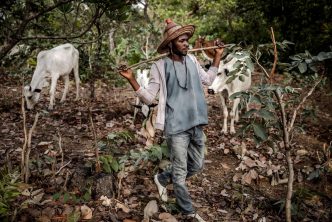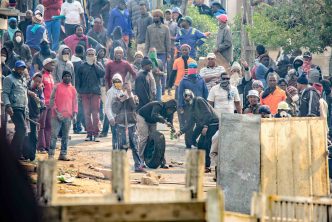Very little is known about the environmental impacts of the decade-long insurgency in North-East Nigeria and how the environment shapes it. A lot that has been written about the ongoing war has focused on the carnage, population displacements, destruction of public infrastructure, and loss of livelihoods in the region. This edition of Nextier Insights reviews the threats of insurgency and counterinsurgency on the biophysical and socioeconomic systems of the North-Eastern region of Nigeria.
Studies show that there is a complex relationship between warfare and changes in the ecosystem. Gary E. Machlis, a professor of conservation, and Thor Hanson, a conservation biologist, termed this relationship the ‘Warfare Ecology’ in their 2008 paper published in “BioScience”. Although ecologists have long been concerned with the impacts of war-related activities on the biophysical environment (see Keegan, 1993 and Townshend, 2005), such concerns were not conceptualised as a new field of study until recently. War Ecology, as a new field of inquiry, is context-specific. It can be investigated at different scales; local, regional and global perspectives. Central to the study of ecology is the interaction among and between organisms and their environment at different scales. Therefore, the impact of war on the ecosystem remains as the unifying theory of war ecology.
The war in the North-East region of Nigeria has had profound ecological and socioeconomic consequences on the region. For instance, territories under the control of Boko Haram are used as training grounds, hideouts or safe havens, and for arms smuggling and concealment. The same can be said for the state’s response to the insurgency which includes troop deployment using tanks, trucks and other heavy equipment.
The necessities of war impact the ecology in war theatres in far-reaching ways. For instance, garrisons, trackways and muster points used by both the insurgents and for government operations have resulted in losses in biodiversity, land degradation, destruction of crops and arable land, soil compaction and alteration in plant cover. The Nigerian military has constructed routeways through the pristine Sambisa Forest to ease troops’ movements, and this has negatively impacted the conservation status of the forest. Similarly, the insurgency and military operations have significantly altered land-use patterns in the region as farmers can no longer access their farms and cattle cannot graze in the area. Even after the war is over, weapon contamination, particularly mines, and unexploded ordinances, will pose a huge risk to residents of the region.
The United Nations Environment Programme (UNEP) found a strong link between land degradation, desertification, and the protracted conflict. This is the case in the Darfur region of Sudan (UNEP, 2007). Given that the North-East region of Nigeria shares the same ecological characteristics with Darfur, there is a high likelihood that the decade-long assault on the region could lead to similar consequences. Boko Haram has repeatedly set bushes ablaze during the dry season. Fire suppresses as well as stimulates certain species of plants. Fire ecology often produces hybrid plant species which in turn affects local animal life that depends upon them. Similarly, repeated air raids by the Nigerian Air Force would have a tremendous impact on flora and fauna in the area.
Population displacement as a result of the ongoing insurgency could alter land-use patterns and may lead to land-use conflict in the future. The displacements have increased the number of refugee camps in the North-East region. The land is in high demand not only for resettlement but also to sustain refugees’ livelihoods and humanitarian assistance. Nigeria may already be experiencing this impact as many refugees are prematurely returning to their former homes while the war is still raging. This population reversal is, in part, a reflection of the shortages of means of livelihood in the host communities and gradual adaptation to the war as a new standard. Similarly, the refugee camps, which are susceptible to transmissible diseases, could be a breeding ground from where diseases are spread to new areas as the refugees returned to their homes.
Given this broad array of ecological consequences of the war in the North-East region of Nigeria, Nextier proposes the following recommendations to guide military operations and conflict resolution in the region.
- The policy framework to guide post-conflict rehabilitation of the North East region should include in-depth environmental accounting and ecological analysis. Government agencies like the North East Development Commission (NEDC) and the Ministry of Humanitarian Affairs, Disaster Management and Social Development (MHADMSD), should work collaboratively with other Ministries to complete the assessment. The collaboration should include ministries of Environment, Health, Agriculture, Defence, and other donor agencies. The collaboration should study, audit and design ways to mitigate the challenge.
- Military operations and post-conflict rehabilitation expenditure should include environmental considerations such as remediation of military sites, forest conservation, clearing of mines, etc. There is a need to recognise (and check) the impact of changes to the climatic conditions in the conflict areas, especially as they exacerbate the threats to human security. Such climatic changes include drought, desertification, climatic variation, etc. Attention should be paid to the impact of human activities such as wood logging which is carried out at an unprecedented rate in the North East region and other parts of the country.
- Nigeria should recognise the critical impact of land availability for agriculture and any plans for economic development and food security. Nigeria needs a Land Bank to collate information of all available land to enable proper planning. Such information would be required to correct the altered settlement and land-use patterns in the North East region. The NEDC and MHADMSD, while designing their return and resettlement programmes, should take cognisance of the availability of land for agriculture and also land earmarked for future development.
- The knowledge of war ecology should be used to guide military planning, operations, policymaking, and post-conflict reconstruction. As is the case in all protracted wars, the environment suffers as much as the people. UNEP’s 2003 post-conflict environmental assessment of Afghanistan highlighted “serious and widespread land and resource degradation. Other issues include lowered water tables, desiccation of wetlands, widespread loss of vegetative cover, erosion, and loss of wildlife”. As Nigeria plans for a post-insurgent North East region, discussion with UNEP and other donor agencies working on the environment should be prioritized.
- The complexity and protracted nature of Boko Haram insurgency and the military campaign to end it has offered Nigeria the opportunity to look at the conflict from diverse perspectives. The widespread consequences of the war coupled with the biophysical and socioeconomic systems call for the application of the science of war ecology to reduce ecosystem loss, environmental degradation and help bring about peace and security in the North-East region of Nigeria.
References
Keegan, J. (1993). A History of Warfare. New York: Vintage.
Machlis, G. E. and Hanson, T. (2008). Warfare ecology. BioScience, Vol. 58(8), 729–736.
Townshend, C, [ed.] (2005). The Oxford History of Modern War. New York: Oxford University Press.
UNEP (2007). Sudan: Post-conflict Environmental Assessment. Nairobi: UNEP.







